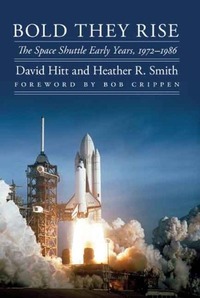Review: Bold They Riseby Jeff Foust
|
| Rather than tell the story of the program through the eyes of one astronaut, they recount the program from the perspectives of more than thirty astronauts who flew on shuttle missions. |
Authors David Hitt and Heather Smith noted the challenges of writing yet another history of the Space Shuttle in the introduction to their new book, Bold They Rise, which covers the history of the program from its origins through the Challenger accident in 1986. (A companion book published last year, Wheels Stop, covers the post-Challenger history of the shuttle.) “Most of the previous works, however, fall into one of three categories,” they write in the book’s preface: technical accounts, individual astronaut biographies, or histories of specific missions or other limited aspects of the overall program.
The authors decided to take a different tack in Bold They Rise: “a book relating the human experience of the Space Shuttle program.” Rather than tell the story of the program through the eyes of one astronaut, they recount the program from the perspectives of more than thirty astronauts who flew on shuttle missions leading up to Challenger. Those people range from Robert Crippen, the pilot of STS-1, to Charles Bolden, the future NASA administrator whose first spaceflight was STS-61C in early 1986, the last mission before the Challenger accident.
The book follows a largely chronological approach to the early history of the Space Shuttle program in the first half of the book, covering the development of the shuttle, the recruitment of the first shuttle-era class of astronauts (including the first women and minorities), and the initial shuttle missions. The second half of the book departs from that strictly chronological approach, covering individual missions by type: satellite deployments and repairs, science missions, military missions, and so on. The book’s final chapter reviews the Challenger accident and its investigation.
The book relies very heavily on interviews astronauts gave as part of the Oral History Project at the Johnson Space Center; without those interviews, the authors acknowledge, the book “would not exist.” That is, ultimately, both the strength and the weakness of Bold They Rise. The strength is that it allows them to follow the shuttle program through the eyes of many people who flew on it, from veteran astronauts like T. K. Mattingly, who came over to the Space Shuttle program from Apollo, to payload specialists like Charlie Walker, who flew to support experiments for his employer, McDonnell Douglas. That diversity of backgrounds—pilot and mission specialist, rookie and veteran—helps provides a greater range of perspectives than an account by a single shuttle astronaut.
| “But she pointed at me and said, ‘I want you to join the astronaut program.’ So, shoot, if Lieutenant Uhura looks at me and says that, that got me thinking about it.” |
The weakness, though, is that it provides a history of the shuttle from only the perspective of astronauts. Engineers, technicians, managers, politicians, and others all played key roles in the development and operation of the shuttle, but their contributions are glimpsed primarily from the view of the astronauts. The authors acknowledge that the book is not a technical volume; it’s also not a political history, and politics shaped the Space Shuttle as much as any other factor.
Also, because the book relies so heavily on JSC’s Oral History Project, an excellent resource but one that has been frequently used by other historians, there are few, if any, major revelations about the shuttle program in the book. A reader already familiar with the program will get some color about the shuttle from the viewpoints of various astronauts, though, and perhaps a few tidbits here and there. Walker, for example, notes that early in his shuttle career NASA went to great lengths to segregate the payload specialists from the career astronauts, to the point of putting the specialists in a different building from where the astronauts’ offices were. Fred Gregory, one of the members of the famous 1978 astronaut class, said he credited a public service announcement featuring actress Nichelle Nichols—Uhura from Star Trek—for piquing his interest in becoming an astronaut: “But she pointed at me and said, ‘I want you to join the astronaut program.’ So, shoot, if Lieutenant Uhura looks at me and says that, that got me thinking about it.”
Bold They Rise overall offers a broad, but not necessarily deep, history of the early years of the Space Shuttle program, when it still had the promise of revolutionizing spaceflight with frequent, less expensive access to low Earth orbit. The shuttle didn’t do that, but it did have capabilities that altered spaceflight for decades to come.
